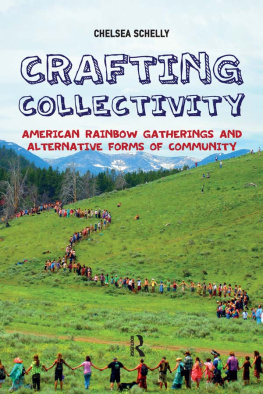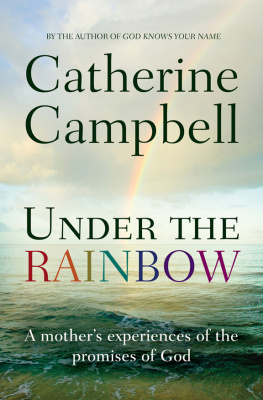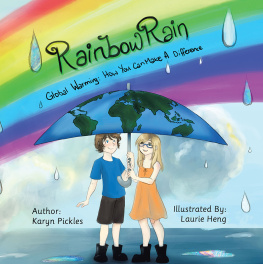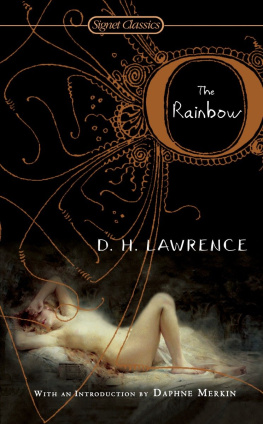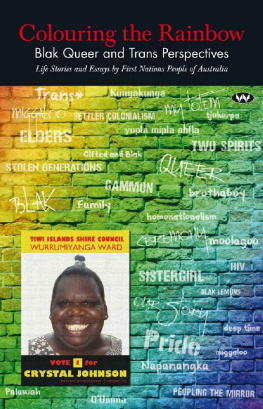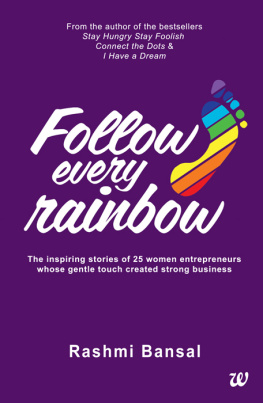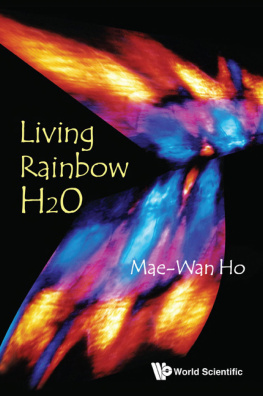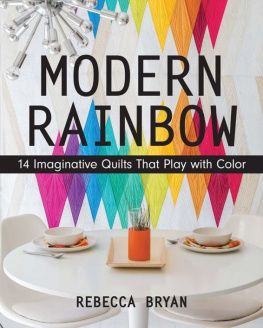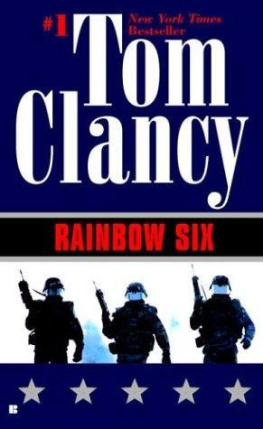CRAFTING COLLECTIVITY
CRAFTING COLLECTIVITY
AMERICAN RAINBOW GATHERINGS AND
ALTERNATIVE FORMS OF COMMUNITY
CHELSEA SCHELLY
First published 2014 by Paradigm Publishers
Published 2016 by Routledge
2 Park Square, Milton Park, Abingdon, Oxon OX14 4RN
711 Third Avenue, New York, NY 10017, USA
Routledge is an imprint of the Taylor & Francis Group, an informa business
Copyright 2014, Taylor & Francis.
All rights reserved. No part of this book may be reprinted or reproduced or utilised in any form or by any electronic, mechanical, or other means, now known or hereafter invented, including photocopying and recording, or in any information storage or retrieval system, without permission in writing from the publishers.
Notice:
Product or corporate names may be trademarks or registered trademarks, and are used only for identification and explanation without intent to infringe.
Library of Congress Cataloging-in-Publication Data
Schelly, Chelsea.
Crafting collectivity: American rainbow gatherings and
alternative forms of community / Chelsea Schelly.
pages cm
Includes bibliographical references and index.
ISBN 978-1-61205-745-3 (hardcover: alk. paper) ISBN 978-1-315-63541-5 (ebook)
1. Rainbow Family of Living Light. 2. UtopiasUnited States. 3. Communities
United States. 4. Alternative lifestylesUnited States. I. Title.
HX806.S2548 2014
307.77dc23
2014012172
ISBN 13: 978-1-61205-745-3 (hbk)
ISBN 13: 978-1-61205-746-0 (pbk)
To baby, and Avery, and the Family.

This book would not have been possible without the support and encouragement of three particular academic mentors. Professor Jean Blocker at the University of Tulsa was the first person to inspire my sociological imagination and the first professor to suggest that I participate in Rainbow Gatherings as a sociological observer. To her, I must say thank you, thank you for believing in my capabilities as a sociologist at the very beginning stages of their development. Professor Peter Taylor at Colorado State University encouraged me to study people who were using technologies in alternative ways to pursue alternative lifestyles, recognizing this as my passion and prompting me to pursue that passion, even when I was timid about it. Thank you, Pete, for nurturing my intellectual enthusiasm and nourishing my personal drive to study and pursue alternatives that benefit the natural world and social relationships. Mustafa Emirbayer at the University of WisconsinMadison, my PhD advisor, recommended quite directly that I study and write about Rainbow Gatherings after he learned about my interest and involvement. Without his support, this book would not have come to fruition. His courses on sociological theory and the Chicago school of sociology introduced me to a sociological tradition that resonates with my own perspective and interest. His mentoring guided my approach, reminding me of what to watch for and how to stay attentive. His own enthusiasm for the project helped keep me energized. His tireless editing, of this project and many others, has drastically improved my written work. To him, I express my deepest gratitude: without you, this book would not have been possible.
There are several other people who made this book possible who also deserve much thanks and appreciation. Thank you to the three young men from Tulsa, Oklahoma, who introduced me to Rainbow Gatherings. Thank you to my partner in life, who has made this dream and many other dreams come true. He attended the 2012 National Gathering with me, taking responsibility for the driving and our dogs, making my long days of extensive field research possible. He has spent considerable time listening to me talk about this project and reading drafts of this manuscript and has always been willing to discuss ideas or share his own experiences. Without his love and support, I would not be where I am today, and this book would not be here either. Thanks to Butterfly Bill for writing his own personal accounts of experiences at Gatherings over the past twenty years, which taught me much about Rainbow Family history, for taking the time to provide extensive feedback on a draft of this manuscript, and for dedicating so much positive energy to the Family. I must also say thank you to my family, who have encouraged and supported my educational journey, and to the Rainbow Family, who have allowed me to learn from them and inspired me in so many ways. This book is for all those who have taught me about the possibilities of freedom, for anyone who knows someone who has been drawn into this world and is wondering about its mysterious appeal, and for everyone who believes that the social and material configuration of our current world is not the only possibility. Finally, I must thank Dean Birkenkamp at Paradigm Publishers for believing in this project.
It was during my first year at college that I learned about Rainbow Gatherings and the Rainbow Family of Living Light. At seventeen years old, Ilike many Americans around that agehad just moved to a new place and was searching for new people, experiences, and ways of life that seemed a better fit for me than what my childhood upbringing had offered. I had already declared my sociology major when I attended my first Gathering, and I have since gone to six National Gatherings as both participant and observer, using sociological insight to understand the Rainbow Family and their Gatherings.
Rainbow Gatherings are temporary events that take place in National Forests throughout America, and those who attend identify as the Rainbow Family of Living Light. This family is a society of fission-fusionan ephemeral collection of people, material systems, and cultural practices that come together and are established, maintained, and then completely dismantled and disappeared only to take shape in another location, again and again, year after year.
Rainbow Gatherings are based on principles of nonviolence and nonhierarchical egalitarianism. is welcome, is home, at a Gathering.
A unique blend of spirituality, anarchy, back-to-the-land living systems, and a leave-no-trace environmental ethic come together as thousands of people gather to party, pray, and experience the heightened sense of connectivity that takes place in this unusual social world. Yet the questions raised and insights offered by examining the world of the Rainbow Family provide more generally applicable insight into how the material organization of our society affects how we organize culturally and how the material and technological systems that support human societies also shape thought, action, and interaction.
Rainbow Gatherings are different from mainstream American society in numerous fundamental ways; they are organized differently both materially and culturally, and they involve different kinds of action and interaction. Some people are attracted to studying deviant groups because they offer the promise of excitement or the exotic. and assign meaning to our physical experiences. Thus, at a Rainbow Gathering, just like in the rest of society, people learn from one another how to behave and how to interact; further, in both this alternative community subculture and in our mainstream culture, the ways we organize the materials, technologies, and physical systems that provide for subsistence and comfort reinforce particular cultural expectations regarding our actions, interactions, and social organization.

